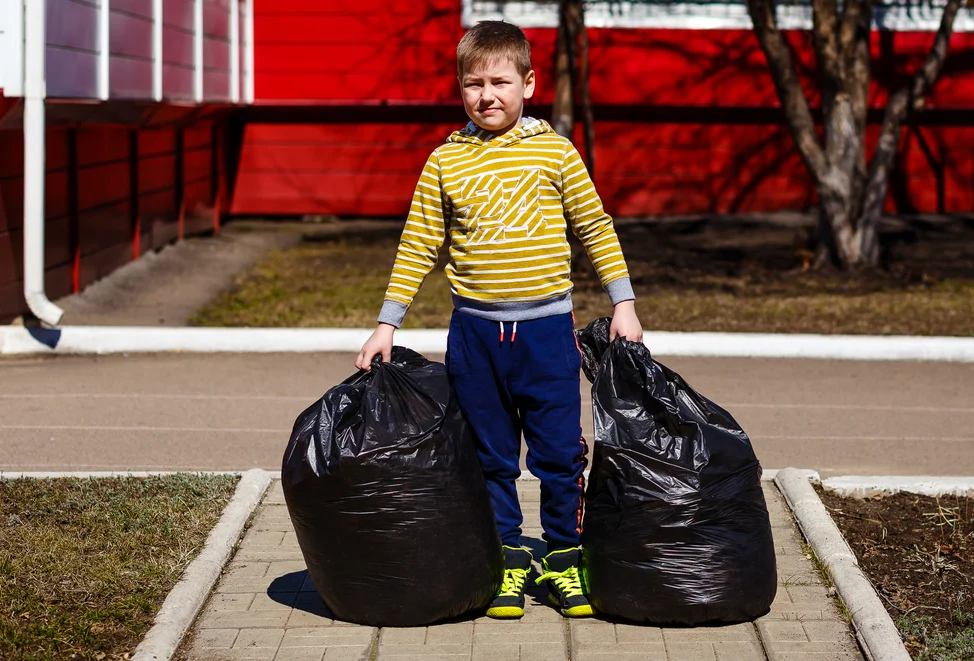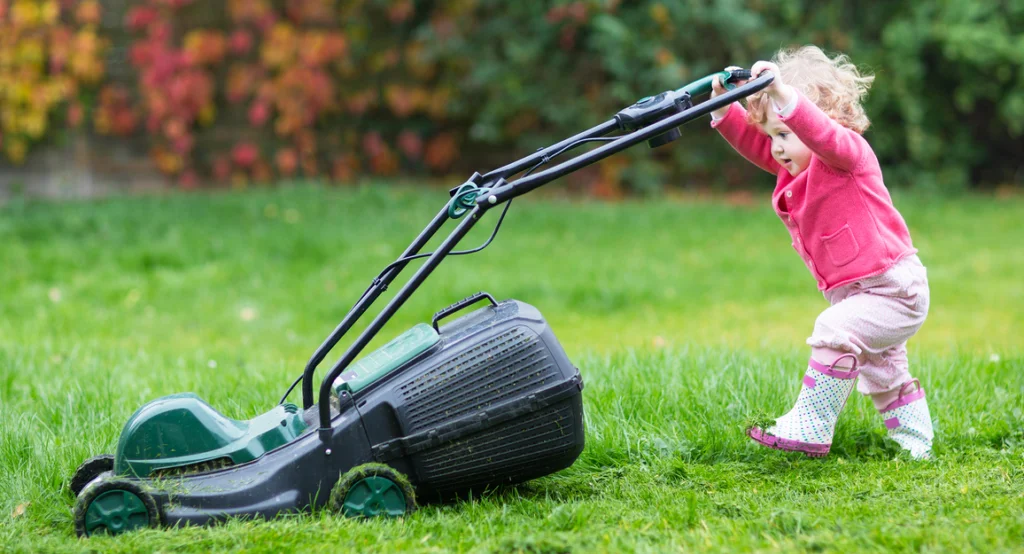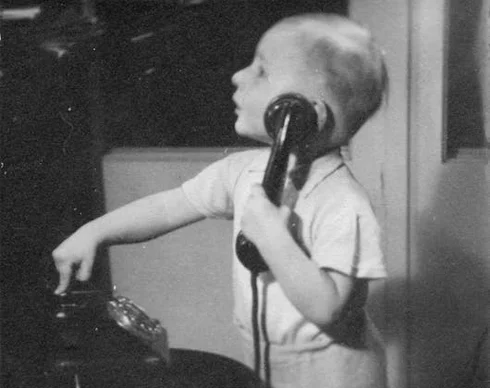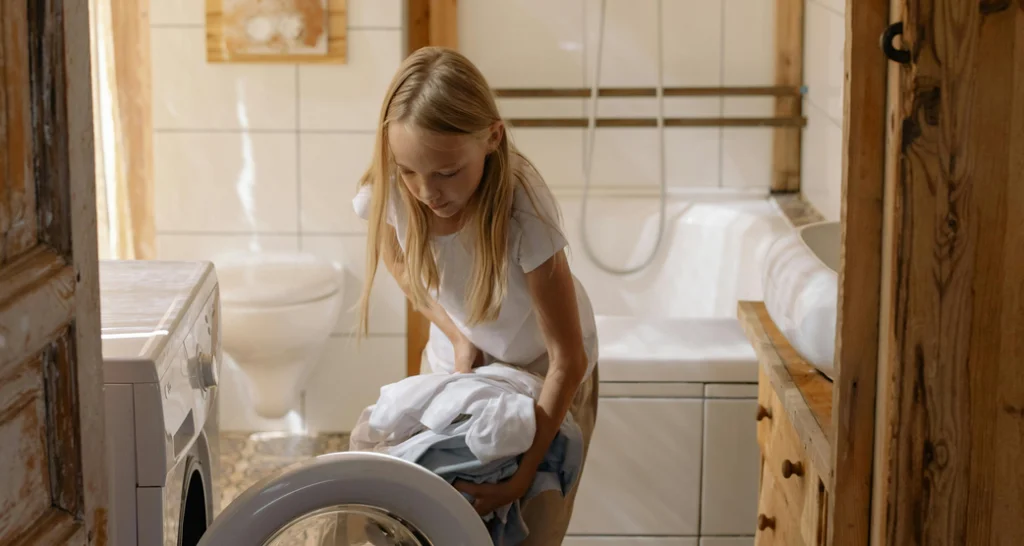Before the age of digital distractions and participation trophies, children of the 1960s were expected to contribute to household operations as a matter of course. These weren’t negotiable tasks but rather assumed responsibilities that came with being part of a family. The baby boom had created larger families, parents were busy with work and community obligations, and the concept of “pitching in” wasn’t just encouraged—it was mandatory. Looking back at these everyday chores reveals not just the practical needs of mid-century households but also the values and expectations of an era when children’s contributions were considered essential to family functioning.
1. Taking Out the Trash

In the pre-recycling era of the 1960s, taking out the trash was a straightforward but essential chore assigned to children as young as six or seven. Metal garbage cans needed to be dragged to the curb once or twice weekly, often requiring multiple trips as disposable consumer culture ramped up and households generated more waste than previous generations. The job frequently involved crushing empty tin cans and folding newspapers to maximize space, as waste management was less sophisticated and pickup schedules less frequent than today. Society Insurance has actionable tips for safely taking out the trash these days.
The unpleasant nature of the task—dealing with food scraps in an era before scented trash bags, risking encounters with insects that had found their way into garbage cans, and sometimes cleaning the cans themselves with a garden hose when they became too odorous—made this a universally dreaded but inescapable responsibility. Yet children performed this chore without the extensive negotiation or reward systems common today, understanding it as their contribution to household maintenance and accepting that everyone, regardless of age, had jobs that simply needed doing.
2. Washing and Drying Dishes

Before the widespread adoption of automatic dishwashers, washing dishes was a nightly ritual that often fell to children, creating an assembly line with one child washing in soapy water, another rinsing, and often a third drying and putting away. The process could take upwards of an hour after large family meals, with children standing on stools to reach into deep kitchen sinks filled with hot, soapy water that turned increasingly murky as the job progressed. Parents insisted on thorough cleaning, often sending inadequately washed items back for a second attempt, with special attention paid to properly scrubbing pots and pans. Philadelphia Magazine lists some of the worthwhile benefits to washing dishes by hand.
The tedium of this daily chore was somewhat offset by the social aspect, as siblings used the time to talk, argue, or engage in water-flicking skirmishes when parental supervision waned. Many adults who grew up in the 1960s recall dishwashing duty as a time of family bonding and conversation, with important discussions about school and friends taking place over sudsy water and damp dishtowels. The rotation of positions (washer, rinser, dryer) was often a source of negotiation among siblings, with drying generally considered the preferred job as it allowed one to stay dry and eventually escape first when the task was nearing completion.
3. Mowing the Lawn

Lawn mowing in the 1960s was a far cry from today’s self-propelled or riding mowers with their safety features and comfort designs. Boys as young as ten were expected to wrestle with heavy, loud, push mowers that required strength and stamina to operate, especially on humid summer days. The satisfying straight lines of a well-mowed suburban lawn were a point of neighborhood pride in an era when front yards served as visible reflections of a family’s standards and work ethic. Ideal Home asks and answers if manual lawn mowers are worth it for the ideal, crisp, clean lawn.
The job came with genuine responsibilities beyond just the physical labor: checking and adding oil, filling the gas tank without spilling, cleaning grass clippings from the undercarriage, and proper storage of the equipment. Many children recall being awakened early on Saturday mornings to “beat the heat” while mowing, a parental strategy that also ensured the family yard looked presentable for any weekend visitors. Girls were less commonly assigned this particular chore in most households, reflecting the gender roles of the era, though they were often expected to handle other outdoor tasks like weeding or gardening instead.
4. Setting and Clearing the Table

In an era when family dinners were non-negotiable daily events, children were responsible for properly setting the table with the correct placement of plates, utensils, napkins, and glasses. This chore taught children the basic rules of etiquette and table setting that were considered essential knowledge in mid-century America. The task required attention to detail, as parents expected proper placement of forks, knives, and spoons according to traditional table-setting standards.
After the meal, clearing the table involved scraping leftover food into the garbage, stacking dishes according to type, and wiping down the dining surface—all without being reminded or supervised. This responsibility was often assigned to younger children as their introduction to household duties, while older siblings handled the more complex task of washing the dishes. The routine nature of meals in 1960s households—happening at the same time daily, with the whole family present—made this chore a predictable part of children’s daily routines rather than an occasional imposition.
5. Making the Bed

Making the bed was a daily expectation in most 1960s households, to be completed immediately upon waking without reminders or supervision. This wasn’t the casual bed-making of today but rather a precise exercise in hospital corners, properly aligned pillows, and smoothed blankets or bedspreads without a wrinkle in sight. Many parents would inspect completed beds, teaching children to take pride in the details and do the job right the first time.
The task was considered fundamental to good character development, with parents frequently quoting adages like “the way you keep your room reflects the way you keep your mind” or “start the day with one accomplishment and others will follow.” Children who shared rooms often developed systems for making bunk beds or synchronized their efforts to complete the chore efficiently, understanding that breakfast might be delayed until all beds in the household met the required standards. This habit was particularly emphasized in households with military parents, where bed-making standards approached those expected in barracks inspections.
6. Dusting and Vacuuming

Weekly cleaning routines typically included children dusting furniture throughout the house using actual feather dusters or treated cloths rather than disposable products. The task required moving decorative items, photographs, and knickknacks—abundant in 1960s home decor—then replacing everything in its precise original position, as mothers would notice even slight displacements of cherished objects. Children quickly learned which surfaces showed dust most readily (the television set and piano were notorious offenders) and which decorative items were most fragile or valuable.
Vacuuming followed dusting and involved managing heavy, cumbersome machines with cloth bags that needed emptying when full—a messy job that often resulted in dust clouds. Children were taught specific patterns for efficient vacuuming, including how to create those satisfying parallel lines in shag carpeting that signaled thorough cleaning. The noise of 1960s vacuum cleaners made this chore particularly disruptive, so children learned to coordinate vacuuming times with family schedules, avoiding dad’s nap time or favorite television programs. Unlike many modern households where cleaning services or robots handle these tasks, regular dusting and vacuuming were considered appropriate responsibilities for children from around age eight onward.
7. Answering the Telephone

In the days before caller ID, voicemail, or even answering machines, children served as the family’s telephone receptionists, expected to answer promptly and politely while taking accurate messages. This responsibility taught proper telephone etiquette, which was considered an important social skill as the family’s main line represented their public communication channel. Children memorized lengthy message-taking protocols that included noting the caller’s name, number, time of call, and detailed message content.
Messages were written on dedicated pads kept near the phone (often with carbon paper for duplicates) and were expected to be complete and legible. Children understood that failing to deliver an important message could have real consequences for family business or social obligations. The task also required discretion, as children were exposed to adult communications and expected not to eavesdrop on conversations—a temptation made more difficult by the lengthy cords that allowed phones to be carried only so far from curious ears. Many adults raised in the 1960s recall the responsibility of being the family message-taker as their first experience with being trusted with important information.
8. Collecting and Sorting Laundry

Laundry day in the 1960s was typically a once-weekly event rather than the continuous process it has become in many modern households, and children were expected to participate in the multi-step operation. The process began with collecting dirty clothes from hampers throughout the house and sorting them according to color and fabric type—a crucial step in an era when washing machines had fewer settings and fabrics were less forgiving of improper treatment. Children learned early which items needed special handling and which could be washed together.
After washing (often handled by mom or older children), younger kids helped with hanging clothes on outdoor lines even in suburban neighborhoods where automatic dryers were becoming common, as many mothers preferred the fresh smell and cost savings of air-dried laundry. The final steps involved folding items according to precise standards and delivering neatly stacked clothing to each family member’s room. Throughout the process, children were taught to respect the family’s possessions and understand the labor involved in maintaining household textiles—a lesson that often resulted in them taking better care of their clothing.
9. Running Errands

Before helicopter parenting and stranger danger concerns, children as young as seven or eight were regularly sent on neighborhood errands, from picking up a forgotten ingredient at the corner store to delivering items to neighbors or dropping letters in the mailbox. These errands taught navigation skills, money management, and appropriate social interactions with shopkeepers and community members. Parents gave specific instructions and expected tasks to be completed promptly, with correct change returned and receipts provided when applicable.
The independence these errands fostered is almost unimaginable by today’s standards, with elementary-aged children often traveling several blocks from home unsupervised, trusted to represent the family appropriately and return directly after completing their mission. Many Baby Boomers recall being sent to purchase cigarettes for their parents (perfectly legal at the time) or being given responsibility for younger siblings during these excursions, expectations that reflected the era’s different approach to childhood capabilities and responsibilities. These small missions built confidence and problem-solving skills while reinforcing the child’s role as a contributing family member whose time and efforts were valued.
10. Ironing

Once children (particularly girls) reached the age of ten or eleven, they were often enlisted to handle simple ironing tasks using heavy metal irons that required careful temperature regulation to avoid scorching fabrics. Starting with handkerchiefs, napkins, and pillowcases, children gradually progressed to shirts and dresses, learning the correct order of operations for different garment parts. In an era when most clothing required ironing and wrinkle-free fabrics were just beginning to enter the market, this represented a significant contribution to household management.
The responsibility came with genuine hazards—burns were not uncommon, and the weight of the equipment made the task physically demanding for smaller children. Nevertheless, parents considered this an essential skill for future household management, teaching techniques like proper spraying of stubborn wrinkles and testing iron temperature on inconspicuous fabric areas. By their early teens, many children were handling all their own ironing needs and contributing to the family’s laundry maintenance, understanding that well-pressed clothing reflected on both personal standards and family reputation in the appearance-conscious 1960s.
11. Babysitting Younger Siblings

With larger family sizes common in the post-war era, older children were routinely expected to watch younger siblings while parents worked, ran errands, or attended evening functions. This wasn’t considered babysitting in the paid sense but rather an extension of family responsibilities that might include preparing simple meals, supervising homework, mediating disputes, and enforcing bedtimes. Children as young as twelve might be left in charge of multiple younger siblings for several hours, especially during summer vacations when parents couldn’t take time off work.
The responsibility carried real weight—older siblings were expected to handle minor emergencies, ensure home security, and make appropriate judgments about when to contact parents or neighbors for assistance. Unlike today’s highly structured supervision with constant contact possibilities, these young caregivers operated with significant autonomy and decision-making authority. Many adults from large 1960s families credit these experiences with developing their leadership skills and emotional intelligence, noting that the responsibility of caring for siblings taught them more about human nature and crisis management than any formal education could provide.
The chores expected of 1960s children reflected not just practical household needs but the values of an era that prioritized contribution over coddling and responsibility over recreation. Parents viewed these tasks as essential preparation for adulthood, teaching skills that would serve their children throughout life while instilling a work ethic that defined the generation. While today’s children might balk at the workload their grandparents shouldered, those who grew up in that era often credit these expectations with building their character, teaching them efficiency, and helping them understand their value within the family structure—lessons that have served them well throughout the decades that followed.


